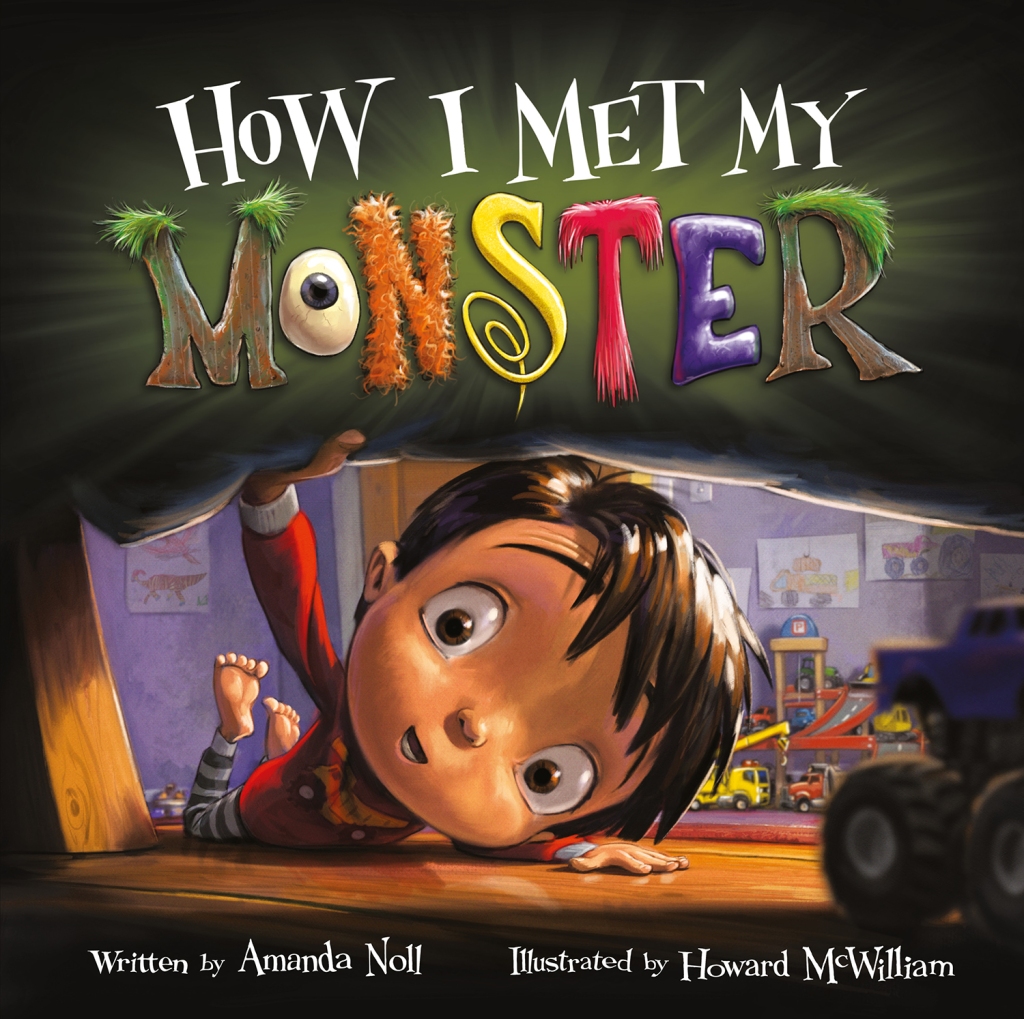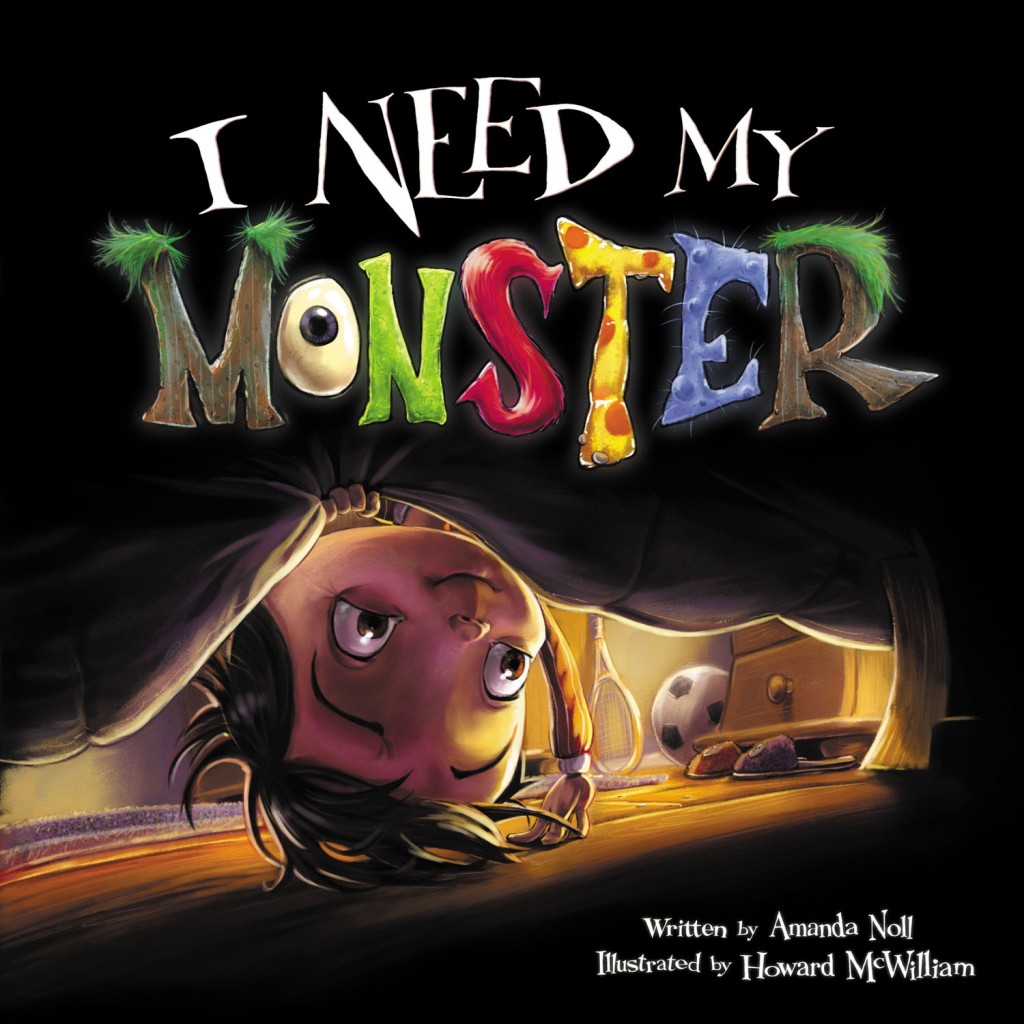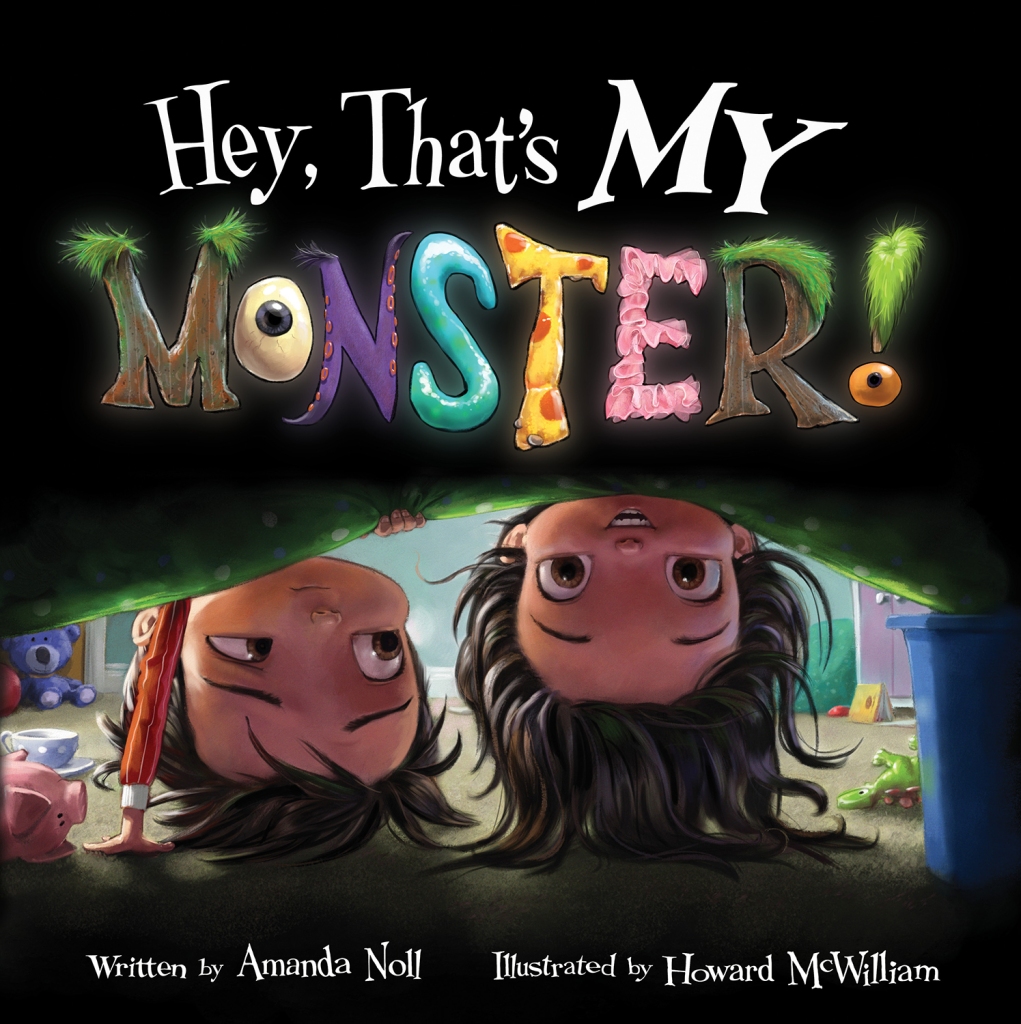Category: Upcoming Books
Happy #NationalMonsterDay!
Celebrate by welcoming the newest member of our Monster family: “Are You My Monster?” – a board book companion for babies and toddlers!

Help Ethan compare his drawing to an assortment of amusing monsters. Do the colors match? Are their tails long or short? Are their nails pointy or round? Are their teeth big or small? Children will be thrilled when Ethan finds the perfect match – which turns out to be his beloved stuffed monster toy – just in time for bed.
“Little ones will enjoy the parade of silly creatures…while also learning colors and matching.The sweet ending shows that even those with sharp teeth and scratchy claws can be cuddly,turning the monster-under-the-bed trope on its head.” – School Library Journal
An author’s thoughts from the ALA Midwinter Conference
Guest blogger: Amanda Noll, author of I Need My Monster and Hey, That’s MY Monster! and two more upcoming monster books!

In January, I had the unique opportunity to participate as an author at the ALA Midwinter Conference in Seattle, Washington, The number of vendors and professionals was staggering, and the whole experience was tremendous. I was hosted by IPG (Independent Publishers Group), the awesome, hardworking team who distribute my books and the entire Flashlight Press line to bookstores.

Librarians began lining up even before it was time for me to start autographing the free copies, and that line didn’t end until we ran out of books, all 100 of them! I’ve never had people queue up to meet me; I almost felt famous! I credit IPG for creating the buzz: they promoted my signing front and center at the Friday night opening session, and that’s when the excitement started to build. Cynthia and the rest of the IPG team kept the line moving and made sure books were ready for the enthusiastic librarians awaiting them.
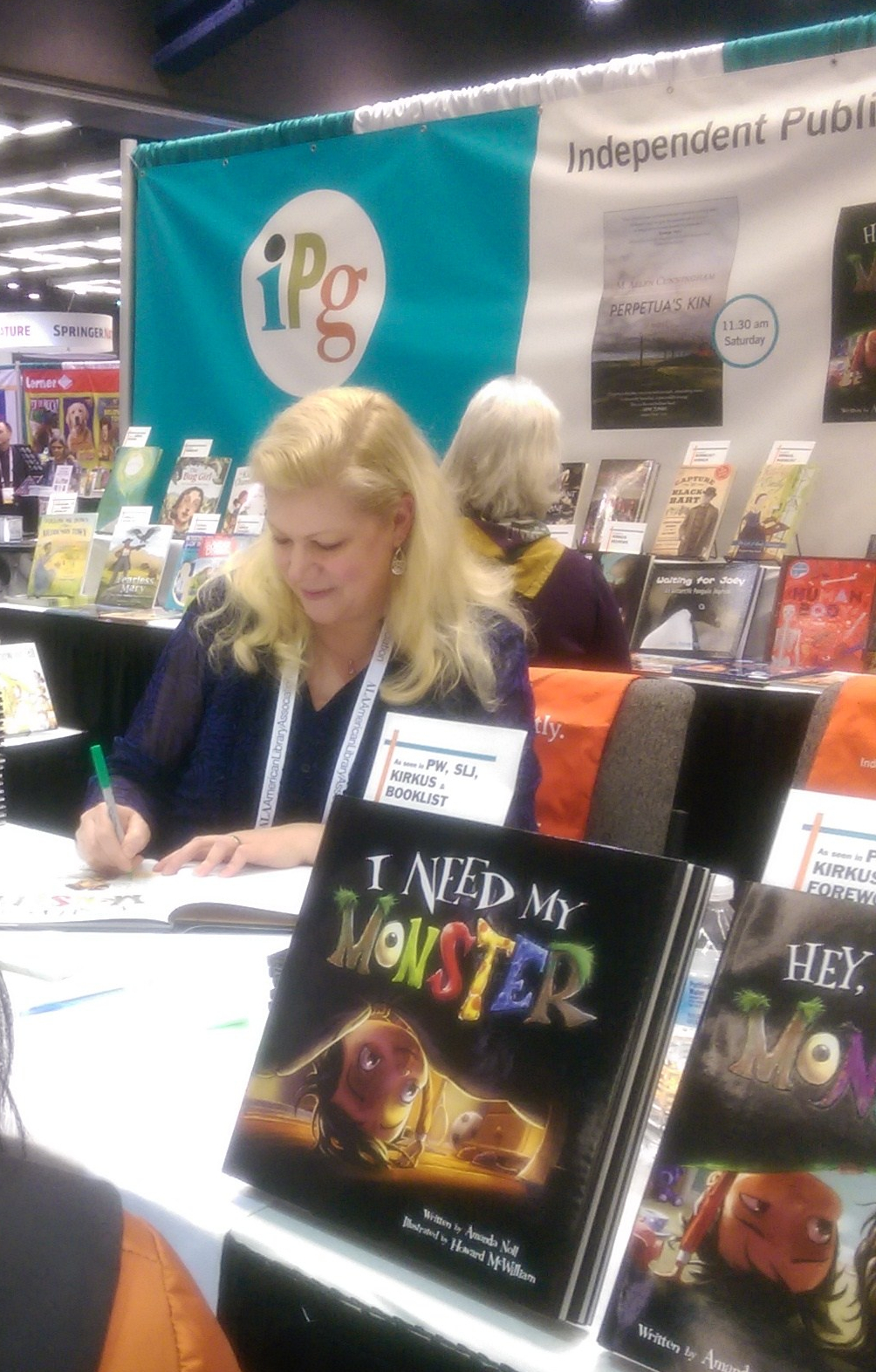
It was thrilling to be at an event where peers and professionals knew and loved my books, and were excited to meet me. I connected with many local librarians, and had a chance to greet and speak with librarians from as far as Brazil and Asia, and from all around the world.
The librarians shared countless stories of reading my books to their young library patrons or students, and to their own children at bedtime. They told me they were absolutely thrilled to see the upcoming board book Are You My Monster (July 2019) as well as the upcoming picture book prequel, How I Met My Monster (October 2019). Flashlight Press prepared gorgeous sell sheets, which the librarians eagerly snatched up.
Signing my books at an ALA conference was a defining moment in my journey as an author. I’m grateful that this milestone can now be checked off my bucket list.
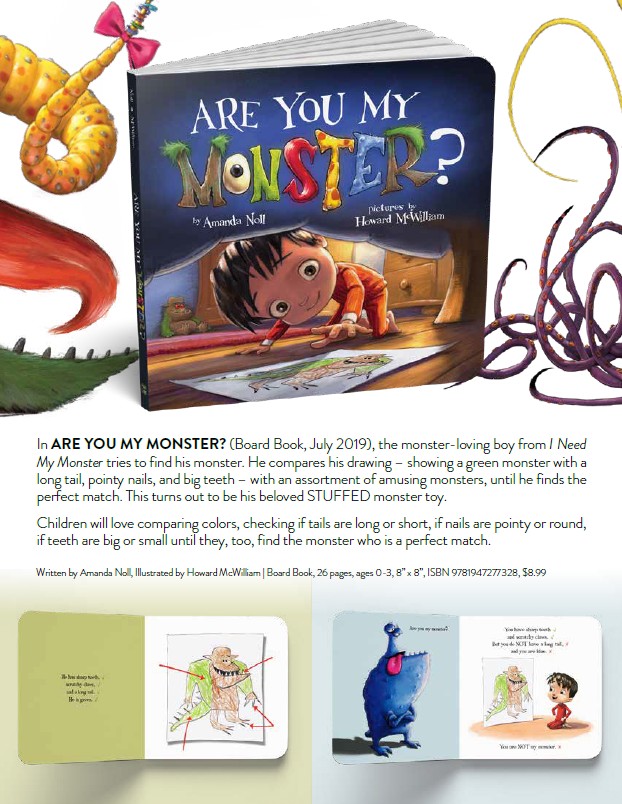
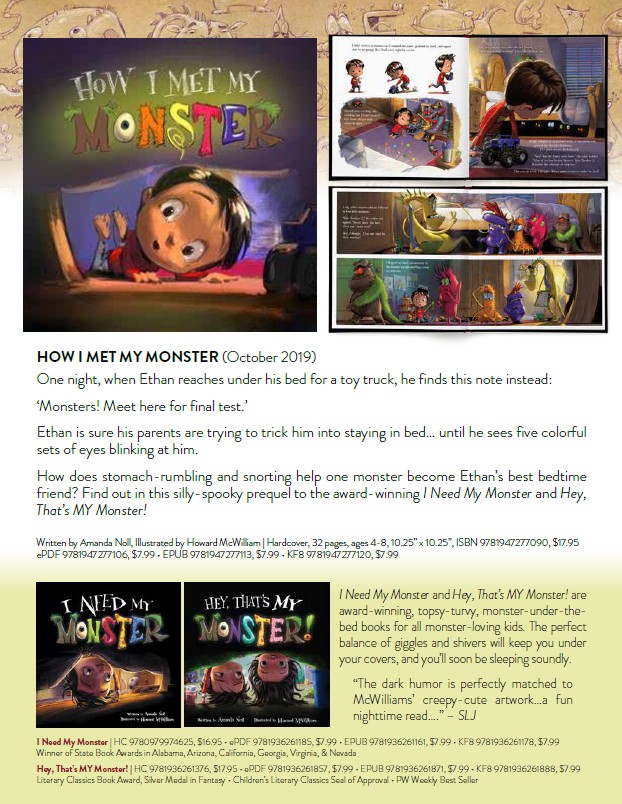
Amanda’s monster books are available through IPG, Barnes & Noble, Amazon, and your local bookseller.
Too Much Glue Ranks #2 in Amazon’s Hot New Releases!
As of this morning, Too Much Glue (written by Jason Lefebvre, illustrated by Zac Retz) was listed as the second “hottest” new release on Amazon in the Children’s Literature category!
This pretty much sums up how we feel about it:
Available now on Amazon, B&N and at your local bookstore!
“…debut illustrator Retz’s artwork is created digitally, but there’s a sculptural quality to it that almost suggests he could be using glue as a medium, too…. First-time author LeFebvre presents a rowdy tale about the disruptive forms that creativity can take.” — Publishers Weekly
Sendak & Co.: Children’s Book Illustrations Since “Where the Wild Things Are”
The work of Courtney Pippin-Mathur, author and illustrator of Maya was Grumpy (Flashlight Press, to be released May 2013), was showcased in Sendak & Co.: Children’s Book Illustrations Since “Where the Wild Things Are,” an exhibition at the Appleton Museum of Art in Ocala, Florida, that opened this Sunday, November 18, 2012.
In addition, Courtney’s watercolor image of Maya with bright orange curly hair, was featured on the promotional postcards. —>
Read about Pippin-Mathur’s exciting experience at the opening via her blog post.
The exhibition runs until January 20, 2013.
There is a Page (to) Click, Like, Pin
 Flashlight Press has embraced the Facebook timeline format. Each of our titles now has its own page. Find your favorites and become a fan by “liking” each book page.
Flashlight Press has embraced the Facebook timeline format. Each of our titles now has its own page. Find your favorites and become a fan by “liking” each book page.
Peruse our colorful catalog by clicking on the image on the right.
Also Flashlight Press is now on Pinterest, so follow us there as well.
Thank you to all for spreading the word about our award-winning titles through reviews, posts, tweets, and pins.
Wishing you all a Spring of Abundance.
Going Dutch! Why Dutch kids are the happiest in the world
Posted on the KaBOOM! site by Guest Blogger: Linda Ravin Lodding on September 14, 2011
 Originally from New York, Linda Ravin Lodding has spent the past 15 years in Austria, Sweden, and now The Netherlands, where she lives with her family in a one-windmill town. She is a working mom, shutter-bug, yoga class drop-out, cheesecake lover, hula-hooper, dreamer, and author of the wonderful children’s book, The Busy Life of Ernestine Buckmeister. Here, she reflects on the child- and play-friendly culture she has encountered in her new home:
Originally from New York, Linda Ravin Lodding has spent the past 15 years in Austria, Sweden, and now The Netherlands, where she lives with her family in a one-windmill town. She is a working mom, shutter-bug, yoga class drop-out, cheesecake lover, hula-hooper, dreamer, and author of the wonderful children’s book, The Busy Life of Ernestine Buckmeister. Here, she reflects on the child- and play-friendly culture she has encountered in her new home:
When my family first moved to the Netherlands, four years ago, it wasn’t just the quaint windmills dotting the landscape that tipped me off that we were living in a foreign land. Nor was it the tractor-wheel-sized rounds of cheese in our village shop. It wasn’t even the picture postcard views of tulips ‘ribboning’ through the fields. No. It was the children – biking, running around, and freely playing outdoors.
Let me explain. When we first arrived in The Netherlands, we decided that we’d “go Dutch” and cycle everywhere. My then nine-year-old daughter was keen. Her school is only a stone’s throw up the street – but it is a busy street with a tricky roundabout . To complicate matters, there are so many cyclists on the bike path that it feels like the Tour de France. So, naturally, I strapped a helmet on her head and off we cycled – together.
It was soon very evident (especially to my daughter) that no other parent was biking with their child like a Mother Goose making way for her gosling. Dutch children were biking by themselves — and not only to and from school. They were biking to the town, to their friends’ houses, to the beach, to their sports activities. I’d see children on bikes and wonder, where was the adult? Granted, kids here are basically born on bikes, but weren’t their parents worried that their little ones would get lost? Side-swiped by a bus? Plucked off the street by a pedophile?
Obviously Dutch parents didn’t have such concerns. Or, if they did, they decided to not let them get in the way of embracing a free-range childhood.
As a friend of mine said, “The dangers have always been here – it’s no more or less dangerous today than it has ever been in Holland, yet parents, on balance, opt to give their kids freedom and independence.” And she, like many Dutch parents, thinks this attitude leads to happier, healthier and more resilient children.
She may very well be right. A 2007 UNICEF study found Dutch children to be the happiest among children in the 21 industrialized countries surveyed.
That well-being seems to be cultivated at a young age through parents, schools and communities. “I want for my child the same kind of playful childhood that I had,” another Dutch friend of mine told me. “I tell my children to go out and play and not come home until their pants are ripped!”
Communities are also on board – especially as childhood obesity is on the rise here in The Netherlands. In an effort to reverse that trend, nearly every Dutch child is engaged in some sort of physical activity. As American schools slash recess and P.E. to make time for more sedentary classroom instruction, Dutch schools provide half-days every Wednesday so kids can pursue sports.
What else explains why Dutch children so happy? Play!
You only have to look at the painting, “Children’s Games” painted by Pieter Bruegel, the Elder over 400 years ago, to see that children in this region have been engaged in independent play for centuries.

And, today, Holland has an abundance of play facilities for children – from construction playgrounds to water playgrounds to natural playgrounds. Just take a look at this Dr. Seuss-inspired playground, featured previously on Play Today, in Hoenderloo, in Netherlands’ Landal Miggelenberg park.
So, I’ve been trying to “go Dutch” in more ways than one. Beyond eating Gouda and tiptoeing through the tulips, I now let my daughter bike to school by herself and ensure that we all make time to lighten up a bit and to play.
Don’t miss Linda’s book! Read about The Busy Life of Ernestine Buckmeister, whose “well-meaning busy parents have packed her after-school hours, turning Ernestine into the over-scheduled poster child of today. But Ernestine is about to opt out and do what no Buckmeister has ever done before: just PLAY.”
Playborhood Interview with Linda Lodding, author of “The Busy Life of Ernestine Buckmeister”

The Busy Life of Ernestine Buckmeister, available for the first time this week, is a great new children’s book about children’s play. Ernestine is scheduled to the max, and she’s not enjoying her life that much. After seeing her next-door neighbor, Hugo, play with abandon in his yard every day, she decides to blow off some of her activities in favor of play. So, she goes to the local park with her nanny, and she plays with Hugo, too.
As I’ve written recently, I’m very concerned about the widespread censorship of play in books, TV shows, and movies aimed at young kids (9 and below). Ernestine is one of my favorite new books in this genre.
Here I present a fascinating interview with the author, Linda Lodding. She provides some great insights into the backstory of the book, as well as how it might contribute to the play movement.
Q: On your web site you note that you didn’t play a lot during your childhood. Why do you consider play so important now that you would write a children’s book encouraging play?
I don’t remember a play-filled childhood in the sense of spending carefree days outside in nature. Thinking back as to why that might have been, I can point to two reasons. Firstly, since my parents grew-up in the New York City, I don’t think they knew how to offer a nature-filled childhood to my sister and me. Secondly, when I was about five, we moved to a house in the wilds of New Jersey, surrounded by dense forest, situated on what was once an Indian reservation. The woods seemed frightening. Grizzly things with fangs, and child-eating witches with gnarly fingers lived in the woods! And, of course, so did the tomahawk-wielding Indians whose land we were living upon. My mother tried to coax me outside to play, (she even took her ironing board outside so that she could iron while I was outside) but I was happier inside with my Barbies. But I did do a lot of imaginative “pretend” play – alone and with friends.
I never set out to write a book encouraging play per se, but was inspired by my own family’s ludicrously funny situation. Like many parents, I set out to enroll my child in as many classes as possible so that she’d quickly find her passion and excel. Of course my daughter’s schedule wasn’t nearly as exaggerated as poor Ernestine’s, but she was falling asleep in her “Ballet for Tots” class and had little energy for her African drumming class. But I also recognized that play time was fundamental to her growth and we eventually pulled back on activities.
Q: In a previous conversation you told me that you added the nanny character in a later revision. What did you have Ernestine doing alone before you added the nanny? How do you think the nanny changes the central message of the story?
Like all books, The Busy Life of Ernestine Buckmeister went through many revisions. In earlier drafts of the book, I had Ernestine running away after school — breaking free from the demands of her after-school schedule to experience play. There was a lot of interest in the book from large publishing houses, but a few editors were concerned that this scene could be perceived as reckless. It’s every parent’s nightmare to lose their child and a few editors were concerned that Ernestine’s actions would alarm to parents. So, I later introduced the character of Nanny O’Dear to allay any potential unease with Ernestine being alone. The added bonus of having Nanny in the book is that she is also a play companion for Ernestine – together they share the joy of play. There’s a lot to be said for adults also participating in play. I don’t think adding Nanny changed the central message of the story which is, ultimately, to let children experience the joy of play.
Q: Why are there so few children’s books depicting children playing outside? Why are there practically none that depict children playing with no adults directly supervising them?
There are books depicting children playing outside, but it’s hard to think of contemporary picture books where children are depicted as playing outside unsupervised. I think this is a direct result of societal fears for our children’s safety. We are bombarded with stories of pedophiles and missing children and these stories send us a chilling reminder that we must be vigilant for our child’s safety or else…As a parent, I can appreciate that it’s a thin line to walk between protecting our children from genuine threats and giving them challenging opportunities in which to learn and grow.
I’m aware, however, of our need to bring in some common sense into this dialogue and blogs and organizations such as yours, 50 Dangerous Things, Re-Thinking Childhood and Free-Range Kids are asking parents to question if our eagerness to be over-protective is detrimental to our children’s maturation process. My focus in The Busy Life of Ernestine Buckmeister was on allowing children to experience unstructured play, whether supervised or not.
But back to your question. While I’m not an editor and don’t make acquisition decisions for publishing houses, my take on the reluctance of depicting unsupervised play in picture books is that since adults are the primary picture book buyers, children’s book publishers are leery of putting stories out there where the child could be perceived as being in danger and thereby alienating book buyers. Naturally, publishing is a business and in order to protect their investment in a book, publishers need to make sure that the book will have a wide-enough appeal.
Interestingly, in older fiction (Easy Readers, Middle Grade and beyond) you can find an abundance of stories where children are playing and exploring unsupervised. I do think that children are drawn to stories where the protagonist is given freedoms that today’s children don’t generally experience — characters that are orphans, or are somehow left to fend for themselves in an adult world. One of my favorites growing up was From the Mixed-up Files of Mrs. Basil E. Frankweiler, where a brother and sisters run away to the Metropolitan Museum of Art. This wouldn’t be the same story if their mother was in tow. And I do think that the hugely popular Magic Treehouse series partially owes it’s kid-appeal to the fact that the kids are on their own solving mysteries. Perhaps this is a way for children to experience freedoms that they haven’t been allowed. But in picture books, you won’t see this kind of characterization – unless they’re talking animals. Pigs and rabbits are allowed to take some risks!
Q: You told me that you weren’t very aware of the play movement before you wrote this book. How do you think that it can contribute to the play movement?
While I was aware of the over-scheduled child phenomenon, I was less aware of the pro-play movement. It wasn’t until The Busy Life of Ernestine Buckmeister was accepted for publication, nearly two years ago, that I started to research the benefits of play. Articles such as “The Virtues of Play” (Wired Science) and “Want your kids to get into college? Let them play!” (CNN) dramatically focus the debate not only for parents but also for students, academicians, and policy experts.
Research shows that children can greatly benefit from unstructured playtime — imagination flourishes, emotional maturity develops, and certain life skills are honed. I learned that play is essential to physical, intellectual and social development and contributes to healthier and happier children. The bottom line is that children who play do better in school and are more likely to become successful adults. The irony is, if our child could take a class that guaranteed that sort of outcome, I think we’d all enroll our kids immediately!
While there are many wonderful organizations that are crusading to put play back into children’s lives and recess back into schools, I’ve yet to come across a picture book that squarely addresses this issue. Hopefully, through the book’s humor, parents will be able to see the light-hearted side of this subject and, if they aren’t already doing so, just may decide to get their kids playing. If my book gets kids and parents laughing and playing, then maybe I can make a small contribution to this important movement.
Q: Let’s say a real-life Ernestine reads this book. Ideally, how would she react?
Ernestine is an exaggerated character, but I don’t think she’s too far off from what some children experience. There are many children who cope beautifully with full-schedules and those kids probably won’t recognize themselves in Ernestine but will enjoy the book on another level. But I also think there are many Ernsts and Ernestines out there who are wishing for time to just be — not to perform, to train, to compete — but just to play. And those young readers may feel sympathetic to Ernestine. If the book starts a family dialogue then that’s a great bonus. But as a writer, my aim is also to entertain and tell a fun story.
Q: In the Netherlands, where you live now, you told me that children have more freedom than they do in the US. Can you characterize the difference? Continue reading “Playborhood Interview with Linda Lodding, author of “The Busy Life of Ernestine Buckmeister””
Check out When a Dragon Moves In’s Cover Art
Fla shlight Press’s upcoming book When a Dragon Moves In isn’t due out until May 2011, but we wanted to give you a sneak peek at the cover now.
shlight Press’s upcoming book When a Dragon Moves In isn’t due out until May 2011, but we wanted to give you a sneak peek at the cover now.
We don’t suggest that you judge a book by its cover, but if this particular cover inspires you, check out more dragon art and the synopsis at our Flashlight web page here.

